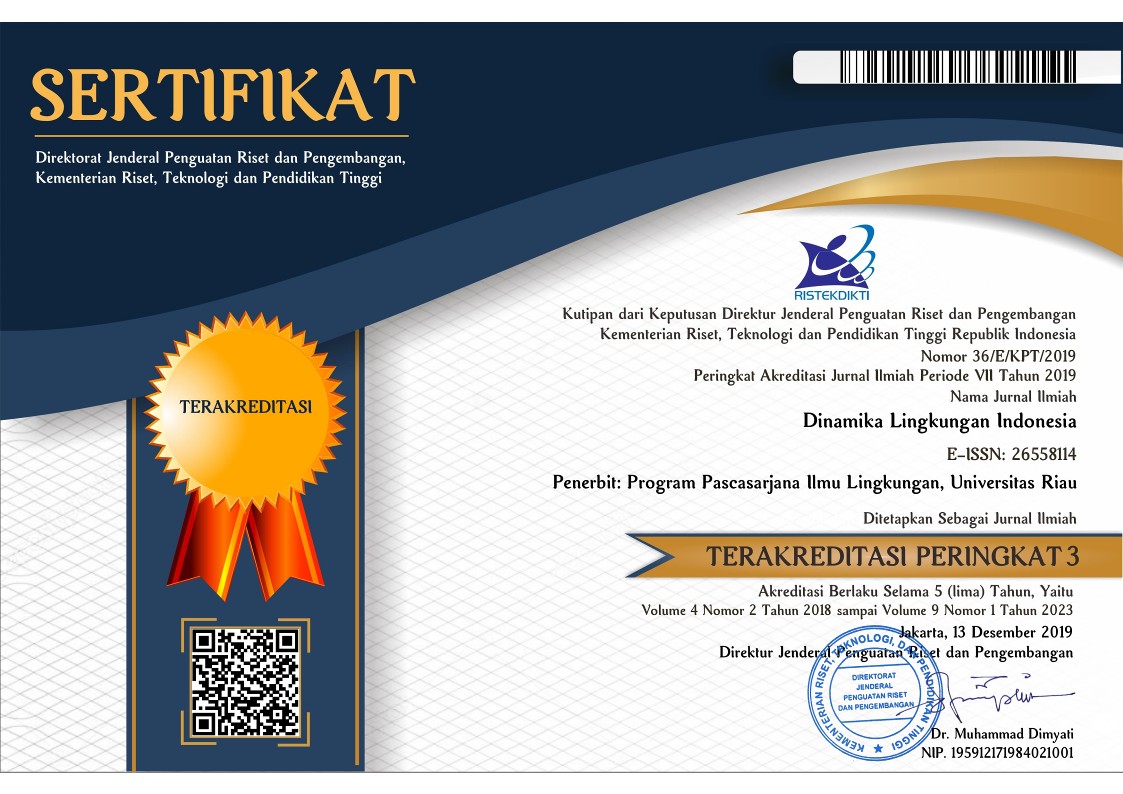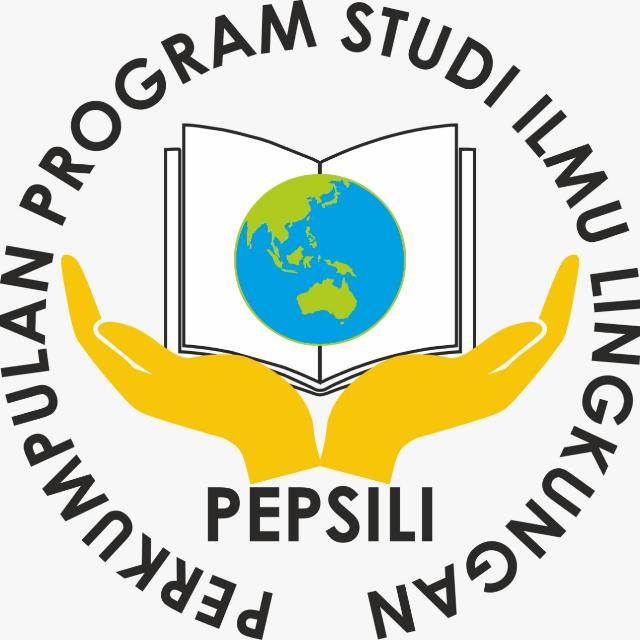Studi Preliminer Pemanfaatan Lumpur Vulkanik Sidoarjo Sebagai Adsorben Zat Warna Napthol di Air Limbah Batik
Abstract
The Sidoarjo Volcanic Mudflow has been one of Indonesia's ongoing national catastrophes since 2006. Numerous studies have been conducted to examine the potential applications of this abundant material due to its massive quantity. In this work, Sidoarjo Volcanic Mud was utilized as a dye-removing adsorbent in batik wastewater. To increase the effectiveness of Sidoarjo Volcanic Mud as an adsorbent, physical and chemical activation techniques were employed, and the results were compared to a control without activation. The sample was heated at 550 °C for three hours to be physically activated. The sample was chemically activated by applying 5N H2SO4 solution for 2.5 hours. In a batch system with an orbital shaker, adsorption tests were conducted for the color removal of pure and pre-treated batik wastewater. Using UV-Vis spectrophotometry, the decolorization of batik wastewater was monitored during the reaction. Due to the high concentration of apparent color in the sample, the effect of the adsorbent activation method was insignificant in pure batik wastewater. In contrast, the effect of the adsorbent activation method was evident in pre-treated batik wastewater, where up to 50% decolorization of the true color was achieved with chemically activated, 18.75% with no activation, and 23.30% with physical activation.
Keywords
Full Text:
PDFReferences
Aljbour, S. H., Al-Harahsheh, A. M., Aliedeh, M. A., Al-Zboon, K., & Al-Harahsheh, S. (2017). Phosphate removal from aqueous solutions by using natural Jordanian zeolitic tuff. Adsorption Science & Technology, 35(3–4), 284–299. https://doi.org/10.1177/0263617416675176.
Astuti, D. H., . S., Fadilla, A. K. N., & Mahendra, Y. I. (2020). Kajian Kualitas Komposisi Adsorben Bahan Baku Lumpur Panas Sidoarjo. Jurnal Teknik Kimia, 14(2), 80–85. https://doi.org/10.33005/jurnal_tekkim.v14i2.2033.
Ciptawati, E., Hilfi Azra Dzikrulloh, M., Oki Septiani, M., Rinata, V., Ainur Rokhim, D., Azfa Fauziyyah, N., & Sribuana, D. (2022). Analisis Kandungan Mineral dari Lumpur Panas Sidoarjo sebagai Potensi Sumber Silika dan Arah Pemanfaatannya. IJCA (Indonesian Journal of Chemical Analysis), 5(1), 18–28. https://doi.org/10.20885/ijca.vol5.iss1.art3.
Daud, N. M., Abdullah, S. R. S., Hasan, H. A., Ismail, N. ’Izzati, & Dhokhikah, Y. (2022). Integrated physical-biological treatment system for batik industry wastewater: A review on process selection. Science of The Total Environment, 819, 152931. https://doi.org/10.1016/j.scitotenv.2022.152931.
Fadhil, O. H., & Eisa, M. Y. (2019). Removal of Methyl Orange from Aqueous Solutions by Adsorption Using Corn Leaves as Adsorbent Material. Journal of Engineering, 25(4), 55–69. https://doi.org/10.31026/j.eng.2019.04.05.
Gul Zaman, H., Baloo, L., Pendyala, R., Singa, P. K., Ilyas, S. U., & Kutty, S. R. M. (2021). Produced Water Treatment with Conventional Adsorbents and MOF as an Alternative: A Review. Materials, 14(24), 7607. https://doi.org/10.3390/ma14247607.
Hubadillah, S. K., Othman, M. H. D., Tai, Z. S., Jamalludin, M. R., Yusuf, N. K., Ahmad, A., Rahman, M. A., Jaafar, J., Kadir, S. H. S. A., & Harun, Z. (2020). Novel hydroxyapatite-based bio-ceramic hollow fiber membrane derived from waste cow bone for textile wastewater treatment. Chemical Engineering Journal, 379, 122396. https://doi.org/10.1016/j.cej.2019.122396.
Jalil, A. A., Triwahyono, S., Adam, S. H., Rahim, N. D., Aziz, M. A. A., Hairom, N. H. H., Razali, N. A. M., Abidin, M. A. Z., & Mohamadiah, M. K. A. (2010). Adsorption of methyl orange from aqueous solution onto calcined Lapindo volcanic mud. Journal of Hazardous Materials, 181(1–3), 755–762. https://doi.org/10.1016/j.jhazmat.2010.05.078.
Kamarudin, N. H. N., Setiabudi, H. D., Abdul Jalil, A., Adam, S. H., & Muhamad Salleh, N. F. (2019). Utilization of Lapindo Volcanic Mud for Enhanced Sono-sorption Removal of Acid Orange 52. Bulletin of Chemical Reaction Engineering & Catalysis, 14(1), 189. https://doi.org/10.9767/bcrec.14.1.3326.189-195.
Khan, T. A., & Nazir, M. (2015). Enhanced adsorptive removal of a model acid dye bromothymol blue from aqueous solution using magnetic chitosan-bamboo sawdust composite: Batch and column studies. Environmental Progress & Sustainable Energy, 34(5), 1444–1454. https://doi.org/10.1002/ep.12147.
Lestari, R. S., & Razif, M. (2019). Pemanfaatan Lumpur Lapindo Sebagai Batako Menggunakan Semen Portland dan Abu Sekam Padi Dengan Stabilisasi/Solidifikasi Kandungan Logam Pb. 7.
Listiyani, N., Dharmawan, A. P., Afifah, F., & Cahyaningrum, S. E. (2019). Pemanfaatan Lumpur Lapindo Sebagai Bahan Baku Pembuatan Amplas. Indonesian Chemistry and Application Journal, 3(1), 24. https://doi.org/10.26740/icaj.v3n1.p24-27.
Mani, S., Chowdhary, P., & Bharagava, R. N. (2019). Textile wastewater dyes: Toxicity profile and treatment approaches (pp. 219–244). In: Emerging and Eco-Friendly Approaches for Waste Management (Bharagava, R. N. & Chowdhary, P., eds). Springer, Singapore.
Mccabe, W., Smith, J., & Harriot, P. (2001). Unit operations of chemical engineering. New York, NY, USA : McGeaw-Hill Inc.
Muhammad, R., & Adityosulindro, S. (2022). Biosorption of Brilliant Green Dye from Synthetic Wastewater by Modified Wild Algae Biomass. Evergreen, 9(1), 133–140. https://doi.org/10.5109/4774228.
Pfeifer, A., & Škerget, M. (2020). A review: A comparison of different adsorbents for removal of Cr (VI), Cd (II) and Ni (II). Turk J Chem, 25.
Prandini, M. N., & Rahmayanti, M. (2020). Effect pH Adsorption of Naphtol Dye Using Humic Acid Adsorbent Result of Peat Isolation from Kalimantan. Proceeding International Conference on Science and Engineering, 3, 147–151. https://doi.org/10.14421/icse.v3.486.
Susanto, A., & Nugroho, P. A. (2012). Pemanfaatan Lumpur Lapindo Sebagai Pengganti Agregat Kasar Beton.
Sutrisno, B., Hidayat, A., & Mufrodi, Z. (2016). Modifikasi Limbah Abu Layang menjadi Adsorben untuk Mengurangi Limbah Zat Warna pada Industri Tekstil. CHEMICA: Jurnal Teknik Kimia, 1(2), 57. https://doi.org/10.26555/chemica.v1i2.3571.
Talib, N. B., Triwahyono, S., Jalil, A. A., Mamat, C. R., Salamun, N., Fatah, N. A. A., Sidik, S. M., & Teh, L. P. (2016). Utilization of a cost effective Lapindo mud catalyst derived from eruption waste for transesterification of waste oils. Energy Conversion and Management, 108, 411–421. https://doi.org/10.1016/j.enconman.2015.11.031.
Ulfindrayani, I. F., Ikhlas, N., A’yuni, Q., Fanani, N., Gaol, B. L., & Lestari, D. (2019). Pengaruh Ekstraksi SiO2 dari Lumpur Lapindo Terhadap Daya Adsorpsinya pada Larutan Metil Orange. CHEESA: Chemical Engineering Research Articles, 2(2), 50. https://doi.org/10.25273/cheesa.v2i2.5108.
Wang, X., Jiang, J., & Gao, W. (2022). Reviewing textile wastewater produced by industries: Characteristics, environmental impacts, and treatment strategies. Water Science and Technology, 85(7), 2076–2096. https://doi.org/10.2166/wst.2022.088.
Zaman, B., & Huboyo, H. S. (2009). Pemanfaatan Lumpur panas sidoarjo sebagai adsorben limbah zat warna tekstil jenis reaktif.
DOI: http://dx.doi.org/10.31258/dli.11.1.p.17-22
Refbacks
- There are currently no refbacks.

This work is licensed under a Creative Commons Attribution 4.0 International License.





